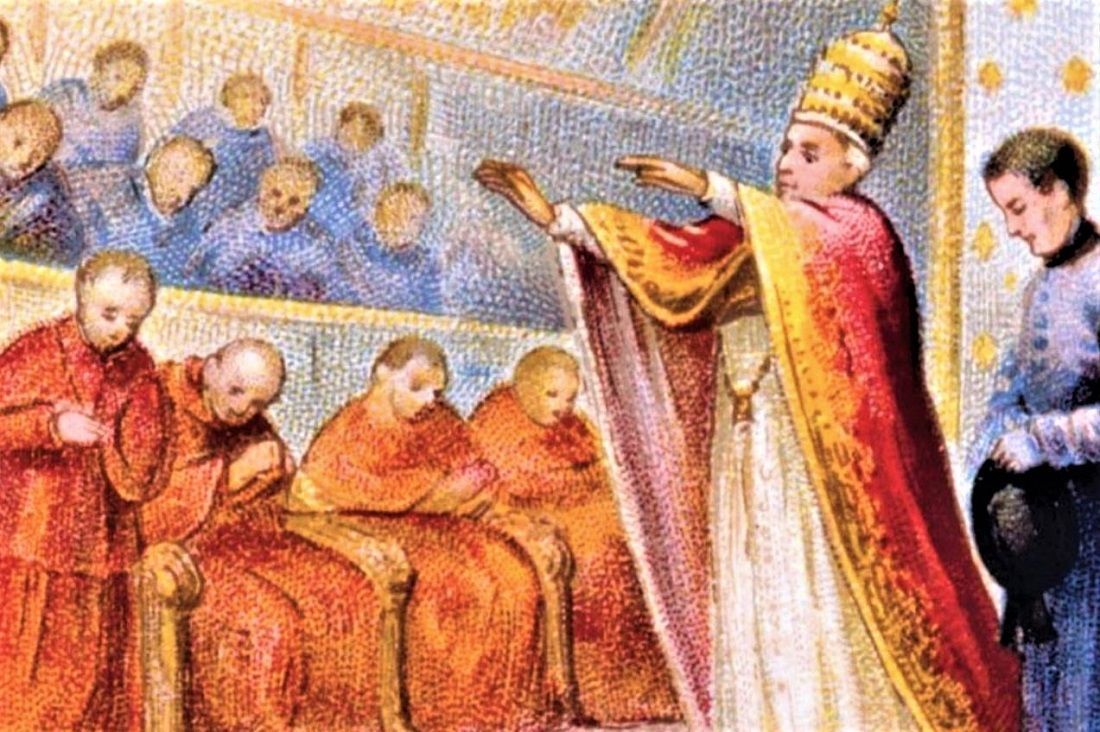The term “ultramontanism” has seen a bit of a resurgence in recent Catholic conversations as a pejorative used by both traditional and progressive Catholics. In so doing, both sides align themselves with doctrinal heterodoxy. Brian Flanagan has recently published a brief study of the term in the National Catholic Reporter, noting the return of the term in “First Things, The New York Times, and the Catholic blogosphere and Twitter.” Like those involved with the term in Catholic journalism and social media, Flanagan too misunderstands the Church’s teaching on ultramontanism.
The extension of the term has shifted in recent years. During the pontificate of Pope Benedict XVI, it was used against traditionally-minded Catholics (those who lauded Pope Benedict’s words, actions, and even shoes) by those who would self-identify as progressive. Today, traditionally-minded Catholics use the term against the progressive or liberal members of the Church who treat interviews with Pope Francis as infallible. In short, a perceived shift between the academic-conservative papacy of Benedict and the pastoral-collegial papacy of Francis has effected a shift regarding who merits (or demerits) the label of “ultramontanist.”
However, the use of the term in this way is dangerous for two reasons: it disassociates the term from its historical significance, thus changing its definition, and it threatens to fundamentally alter our regard for papal authority.
The term “ultramontanism” arose as an epithet essentially invented by the Gallicans. After the English and Protestant Reformations, much of Europe abandoned communion with Rome and constructed national churches. In places like France, a strong desire arose within the Catholic Church to follow suit. In short, the Gallicans wished for local authority (both secular and religious) to be free of too much meddling from the papacy, that man “beyond the mountains” of the Alps. The idea was that the papacy certainly had no authority over the state in secular matters. In religious matters, papal primacy could be trumped by the local ordinary and the customs of his diocese. According to the Liberties of the Gallican Church, if the pope wished to exert himself in France, he must have the consent of the king.
Gallicanism was condemned as heretical at the First Vatican Council wherein it was stated, “we condemn and reject the opinions of those who hold that this communication of the supreme head with pastors and flocks may be lawfully obstructed; or that it should be dependent on the civil power, which leads them to maintain that what is determined by the apostolic see or by its authority concerning the government of the church, has no force or effect unless it is confirmed by the agreement of the civil authority.” In other words, papal authority is not in need of local ratification. These words were (and remain) controversial. They were the genesis of the schism of the Old Catholic Church.
But how does the historical usage of the term “ultramontane” hold any significance for us today? Given that the term arose as an insult against those who challenged the claims of Gallicanism, and given that those who championed papal primacy over local kings and bishops were legitimized at Vatican I, the term ought not to be associated with heterodoxy but rather orthodoxy. This is precisely why Umberto Begnigni writes in the 1912 Catholic Encyclopedia, “For Catholics it would be superfluous to ask whether Ultramontanism and Catholicism are the same thing: assuredly, those who combat Ultramontanism are in fact combating Catholicism, even when they disclaim the desire to oppose it.”
Of course, there is an extreme theory of papal authority which ought to be rejected. Neither Vatican I nor any other ecumenical council teach that each jot and tittle of every papal appearance or interview is infallible, nor even that it demands the complete assent of the faithful. However, this phenomenon would be better termed something like “super-ultramontanism” or “ultra-ultramontanism.” Both of these terms are admittedly clumsy but at least they are doctrinally and historically proper.
To use a term which has heretofore represented orthodoxy in order to condemn heterodoxy risks moving the goalposts of our own understanding of papal authority. We risk legitimizing whatever hidden Gallicanism remains within the Church or even creating a neo-Gallicanism, one which is shaped not by geographical boundaries but ecclesiastical-political ones. A term which used to signify the character of papal primacy now becomes a way to condemn the content of a competing faction within the Church. Yesterday, the term could be levied against “conservative” Catholics. Today, it can be raised against “liberal” Catholics. All the while, we are further entrenching ourselves into neo-Gallican camps which erode away a healthy view of the papacy, substituting a filial benefit-of-the-doubt with the compartmentalization of the modern papacies into boxes and the knee-jerk responses to headlines which this effects.
I am not advocating for a theological indifferentism within Catholicism. Historically, some popes have been significantly more theologically praiseworthy than others. However, it is the content of a papal pronouncement itself which must be judged against the backdrop of the tradition. As we know, the Seat of Peter is not a voluntaristic office wherein one pontiff undoes the work of his predecessor based upon his theological slant. This may be how contemporary Western political office works (wherein all is about power), but it is not how the Petrine authority works. The office of the papacy is one which is charged primarily with safeguarding the unified tradition and the Deposit of the Faith.
As such, there is a certain responsibility on the part of the faithful to approach the words of the Holy Father with a proper measure of reverence and loyalty. Traditionally-minded Catholics must be careful not to immediately question the words of Pope Francis as if this were a default approach. No doubt, the scandals currently plaguing the American Catholic Church have made it tempting for some to blame clericalism or ultramontanism as their cause, or at least as holding back the solutions. However, it would be gravely dangerous to include among our efforts of reform on sexual abuse a reformation of the authority and office of the papacy itself. We cannot abandon Catholicism in order to save the Catholic Church.
There are extremes of deficiency and excess in regard to papal obedience that ought to be avoided, but the golden mean is ultramontanism. Questioning the meaning or prudence of a particular papal utterance on theological grounds by calling it “ultramontanism” neuters the very authority which safeguards the tradition that any particular Catholic must call upon to make the critique in the first place.
EDITORIAL NOTE: This reflection was an invitation to the McGrath Institute’s conference at Notre Dame celebrating the 50th anniversary of Introduction to Christianity. The event featured many of the world’s preeminent experts in the field of Benedict XVI’s thought.


